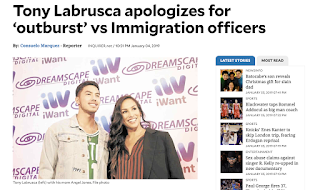Media Framing
Media framing is the concept of placing certain events into a field of meaning by manipulating how certain details of the event are either blown up or swept subtly under the carpet. It is the idea of influencing a viewer's perception of an event for certain various purposes, for example: a news outlet could "neutralize" incriminating news about a certain school if a majority of the staff are alumni of said school or if the writer themself is an alumni. Another common example can be found in the field of politics, in which a "liberal" news outlet antagonize a certain politician because of their traditional of conservative views.
Here's something fresh from the press: American-born actor Tony Labrusca lashes out at the Bureau of Immigration for permitting him a 30-day allowable visit.
1.
In this first article from the Philippine Star, the headline focuses on Labrusca's initial out-lash, giving all the facts and laying out the timeline of the events that unfolded. The article is void of any opinion from the author and appears to be completely objective. However, there is no mention of any apology whatsoever in spite of being published 5 hours after the next article.
2.
Five hours earlier, INQUIRER.net publishes this story, which frames the event in a drastically different light. There are barely any details of the altercation (Labrusca's initial tweet, the immigration officer's response, etc.) and mainly expounds on Labrusca's apology and the BI's response. One might even consider the picture featured as a manipulative nudge in the direction of the actor's favor, in which we see a smiling Labrusca with his mother, unlike the picture in the Star article which features an almost apathetic looking man.
3.
This last article from ABS-CBN news is almost identical to the previous Inquirer one, the biggest difference being the phrasing used for the main headline. From the headline, the event is framed as a mere "incident" and not a somewhat battle, as the Inquirer put it. The article contains similar contents, narrating Labrusca's apology and the BI's response, or rather, their reaction.
In conclusion, the way that news is presented, the details presented, and the current social climate in relation to how the details are presented is vital to the impact the information will make on a reader. As much as possible, one must approach any news article with extreme caution and view the information as objectively as possible. So, don't believe right away and check your sources!
Until next time,
TheLonelyDanisaur







0 comments